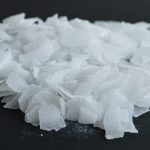Paraffin Wax In Industry
Paraffin or alkane is the common name for all saturated, aliphatic hydrocarbons of the chemical formula CnH2n+2. At room temperature and pressure the first four members of the normal series (Methane, Ethane, Propane and Butane) are gases, the next thirteen are liquids, while the rest are solids. The paraffins are the least toxic of all hydrocarbons. The name paraffin is also commonly used for an oily petroleum distillate, which is a mixture of hydrocarbons. It is believed that the perceived chemical inertness of the compounds led to the name paraffin from parum (little) andaffinis (related).
Paraffin wax is a white or colorless soft solid derivable from petroleum, coal or shale, that consists of a mixture of hydrocarbon molecules containing between twenty and forty carbon atoms. It is solid at room temperature and begins to melt above approximately 37 °C (99 °F); its boiling point is >370 °C (698 °F). Common applications for paraffin wax include lubrication, electrical insulation, and candles.

Properties
Paraffin wax is mostly found as a white, odorless, tasteless, waxy solid, with a typical melting point between about 46 and 68 °C (115 and 154 °F), and a density of around 900 kg/m3. It is insoluble in water, but soluble in ether, benzene, and certain esters. Paraffin is unaffected by most common chemical reagents but burns readily. Its heat of combustion is 42 kJ/g.
The hydrocarbon C31H64 is a typical component of paraffin wax.
Paraffin wax is an excellent electrical insulator, with a resistivity of between 10 and 10 ohm metre. This is better than nearly all other materials except some plastics (notably Teflon).
Paraffin wax is an excellent material for storing heat, with a specific heat capacity of 2.14–2.9 J g−1 K−1 (joules per gram kelvin) and a heat of fusion of 200–220 J g−1. This property is exploited in modified drywall for home building material: a certain type of wax (with the right melting point) is infused in the drywall during manufacture so that it melts during the day, absorbing heat, and solidifies again at night, releasing the heat. Paraffin wax phase-change cooling coupled with retractable radiators was used to cool the electronics of the Lunar Rover. Wax expands considerably when it melts and this allows its use in wax thermostatic element thermostats for industrial, domestic and, particularly, automobile purposes.
Manufacturing
The feedstock for paraffin is slack wax, which is a mixture of oil and wax, a byproduct from the refining of lubricating oil.
The first step in making paraffin wax is to remove the oil (de-oiling or de-waxing) from the slack wax. The oil is separated through crystallization. Most commonly, the slack wax is heated, mixed with one or more solvents such as a ketone and then cooled. As it is cooled, wax crystallizes out leaving oil in solution. This mixture is filtered into two streams: solid (wax plus some solvent) and liquid (oil and solvent). After the solvent is recovered by distillation, the resulting products are called “product wax” (or “press wax”) and “foots oil”. The lower the percentage of oil in the wax the more refined it is considered (semi-refined versus fully refined). The product wax may be further processed to remove colors and odors. The wax may finally be blended together to give certain desired properties such as melt point and penetration. Paraffin wax is sold in either liquid or solid form.
Applications
In industrial applications, it is often useful to modify the crystal properties of the paraffin wax, typically by adding branching to the existing carbon backbone chain. The modification is usually done with additives, such as EVA copolymers, microcrystalline wax, or forms of polyethylene. The branched properties result in a modified paraffin with a higher viscosity, smaller crystalline structure, and modified functional properties. Pure paraffin wax is rarely used for carving original models for casting metal and other materials in the lost wax process, as it is relatively brittle at room temperature and presents the risks of chipping and breakage when worked. Soft and pliable waxes, like beeswax, may be preferred for such sculpture, but “investment casting waxes,” often paraffin-based, are expressly formulated for the purpose.
In a pathology laboratory, paraffin wax is used to impregnate tissue prior to sectioning thin samples of tissue. Water is removed from tissue through ascending strengths of alcohol (75% to absolute) and the tissue is cleared in an organic solvent such as xylene. The tissue is then placed in paraffin wax for a number of hours and then set in a mold with wax to cool and solidify; sections are cut then on a microtome.
Property Value
|
|
| Paraffin wax is a white or colorless soft solid derivable from petroleum, coal or shale, that consists of a mixture of hydrocarbon molecules containing between twenty and forty carbon atoms. It is solid at room temperature and begins to melt above approximately 37 °C (99 °F); its boiling point is >370 °C (698 °F). Common applications for paraffin wax include lubrication, electrical insulation, and candles. It is distinct from kerosene, another petroleum product that is sometimes called paraffin.In chemistry, paraffin is used synonymously with alkane, indicating hydrocarbons with the general formula CnH2n+2. The name is derived from Latin parum (“barely”) + affinis, meaning “lacking affinity” or “lacking reactivity”, referring to paraffin’s unreactive nature.
|
In chemistry, paraffin is a term that can be used synonymously with “alkane”, indicating hydrocarbons with the general formula CnH2n+2. Paraffin wax refers to a mixture of alkanes that falls within the 20 ≤ n ≤ 40 range; they are found in the solid state at room temperature and begin to enter the liquid phase past approximately 37 °C (99 °F). The simplest paraffin molecule is that of methane, CH4, a gas at room temperature. Heavier members of the series, such as octane, C8H18, and mineral oil appear as liquids at room temperature. The solid forms of paraffin, called paraffin wax, are from the heaviest molecules from C20H42 to C40H82. Paraffin wax was identified by Carl Reichenbach in 1830. Paraffin, or paraffin hydrocarbon, is also the technical name for an alkane in general, but in most cases it refers specifically to a linear, or normal alkane — whereas branched, or isoalkanes are also called isoparaffins. It is distinct from the fuel known in the United Kingdom, Ireland and South Africa as paraffin oil or just paraffin, which is called kerosene in most of the U.S. , Canada, Australia and New Zealand. The name is derived from Latin parum (“barely”) + affinis, meaning “lacking affinity” or “lacking reactivity” indicating paraffin’s unreactive nature)
100’s of WAX PRODUCTS
1,000’s of uses for waxes
- By Type
- Paraffin Wax
- Microcrystalline Wax
- Petrolatum
- Non Petroleum Based
- Water Based Emulsions
- By Industry
- Candle Wax Blends
- Packaging and Corrugated Wax
- Thermostat & Distillation
- Agriculture
- Cosmetics and Personal Care
Major Industries
The candle, packaging, thermostat and distillation industries are all major users of wax. Please click on the links at the left for details on IGI’s products for these industries.






